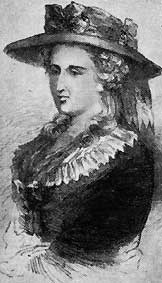|
Of Real and Imagined Terrors

Ann Radcliffe originated the gothic/horror romance genre and many copied her, but few were able to master the genre the
way she did. Her books were widely imitated, with varying degrees of success, but too many of the imitators used the props
of crumbling castle, desperate villians, monstrous crimes, unspeakable horrosr, and supernatural happenings, but without
bothering to create a plot to use them in.
Ann Radcliffe was the most popular writer of her day and almost universally admired. Contemporary critics called her
the mighty enchantress and the Shakespeare of romance-writers. Her popularity continued through
the nineteenth century; for Keats, she was Mother Radcliffe, and for Scott, the first poetess of romantic fiction.
Little was or is known about Radcliffe's life, so not surprisingly apocryphal stories sprang up about her: it was reported
that she had gone mad as a result of her dreadful imagination and been confined to an asylum, that she had been captured as
a spy in Paris, or that she ate rare pork chops before retiring to stimulate nightmares for her novels; several times she
was falsely rumored to be dead. She seems to have been happily married and to have been fortunate in having a husband who
encouraged her to write. There is no explanation for why, at the age of thirty-two, the most popular writer of her times stopped
publishing; there is of course much speculation by her biographers and by literary critics. In 1833, years after her death,
her husband published some of her poems and a historical romance, Gaston de Blondville; it is not clear that she intended
to publish these works. Gaston de Blondville is of interest because it is her only novel that does not explain away
the supernatural happenings and because it contains, apparently as a preface, her thoughts on the sublime and Gothic fiction,
|
 |
|

